ASUS ML248H: Thin for the Win?
by Chris Heinonen on October 27, 2011 12:00 AM ESTViewing Angles and Color Quality
The ASUS ML248H uses a TN panel, and viewing angles are always one thing that suffers with TN. With the monitor on my desk and tilted back, I can see a color and brightness shift from top to bottom quite easily. I found myself wishing that I could either reduce the height to make the center of the screen more even with my eye level, or have it higher and tilted forward a bit to accomplish the same thing. This gets worse with the larger the TN panels as well, but the lack of adjustments available in the ML248H made it a bit hard to see sometimes.
I will note that the ML248H has a tilt adjustment, but my review unit had the screw that connects the base to the monitor go missing at some point. Because of this I couldn’t use the tilt mechanism without worrying the monitor would fall off the stand and potentially be damaged. It’s possible that with this adjustment the angle would not have bothered me as much, but I was not able to get a replacement screw in time for testing. I did find that a spare bolt I had laying around from IKEA was the correct threading to fit, but the connection wasn’t as tight as with the original screw.
Color Quality
Our color testing uses the same procedure as in previous reviews, specifically, we test before and after calibration using ColorEyes Display Pro with an Eye One Display 2 colorimeter. We’ll start with the out-of-box experience.

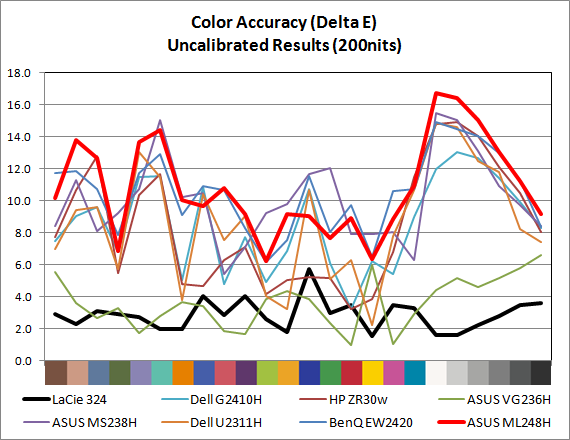
Pre-calibration, the ML248H suffers from a delta E (dE) over 10, with large errors across the whole spectrum. The grayscale is particularly bad, with errors all in the double digits. This isn’t too surprising at all, as most monitors ship this way—particularly budget (TN) displays.
For our calibrated readings, I used the Standard mode and the User color settings to get the white point as close to D65 and the light output at 200 nits (or slightly above) as possible. This was particularly tricky on the ASUS as when I adjusted the white balance, any change to the contrast would send the grayscale out of alignment and add a very blue tone to the image. I wound up having to choose a level around 210 nits of output before I calibrated the white point to allow myself the headroom to get the white balance correct and still be above 200 nits. You can also enable DDC control and get almost identical results to what I did by hand, if your hardware supports it, and save yourself a lot of time.
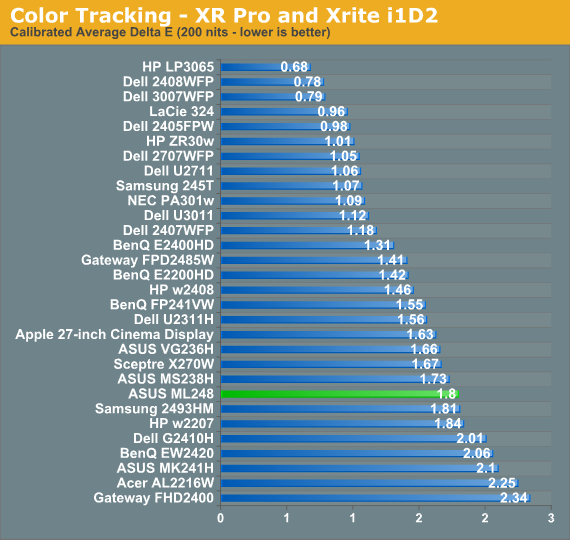
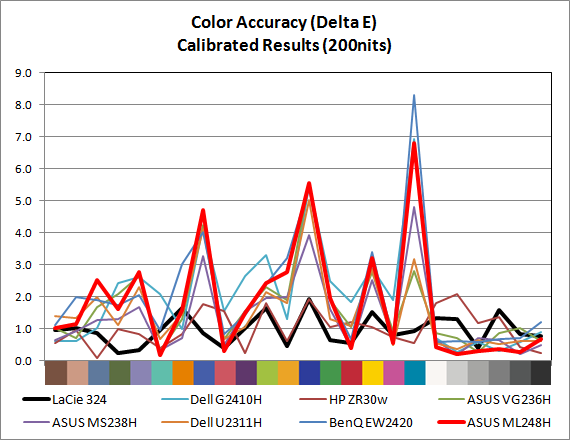
For a monitor targeting the sRGB colorspace, the ML248H does pretty well with a dE of 1.80 for the center. The maximum dE is 6.81, which occurs on a shade of cyan that does not fall inside of the sRGB colorspace, so there will always be an error unless the monitor can do the Adobe RGB colorspace. The median dE is only 1.32, which indicates that the majority of colors are closer to accurate than the average dE indicates, but a few are far off. These are typically blue heavy colors, often at the edge or outside the sRGB colorspace, and those are skewing the results as well.
Also looking carefully at the results, we see the grayscale values in the chart all have values below 0.43 dE, other than black which is 0.68 but also far more subject to measurement error due to its low light output. With all dE values above 3 falling in colors that are predominantly blue, and the grayscale being very neutral, color is overall pretty good on the ASUS. It’s not ideal of course, but it is better than the overall number of 1.80 might lead us to believe.
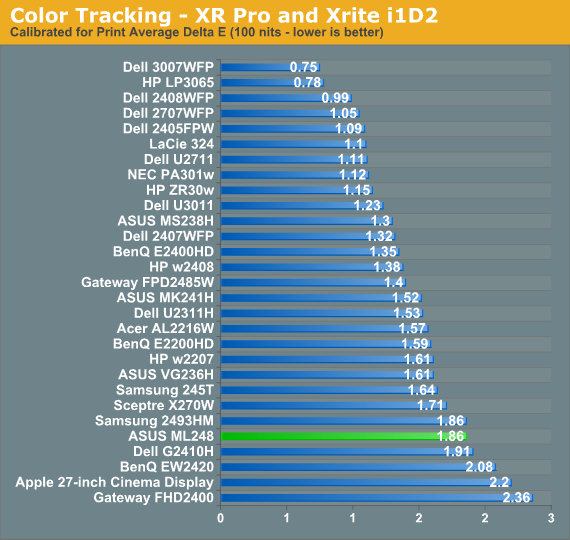
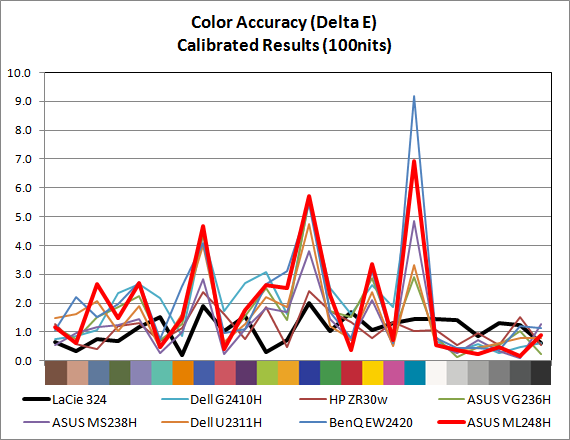
The result for 100 nits is almost identical. The dE is 1.86 on average, with a very good grayscale and issues with the blue samples that fall outside of the sRGB colorspace or at the edge of it. The LEDs don’t seem to discolor at higher or lower output levels, which is also good.















57 Comments
View All Comments
Exodite - Thursday, October 27, 2011 - link
Gladly.Point being that not everyone appreciates, or even sees, the same thing.
Displays are entering an era of holier-than-thou douchebaggery (I just made up a word!) that has long been reserved for audiophiles.
The analogy is apt, I've yet to come across a modern computer where I've considered it worth the money to upgrade from integrated audio solutions.
Same holds for TN vs. IPS, PVA/MVA etc.
Broheim - Thursday, October 27, 2011 - link
lol@"TN is still the best", IPS is superior in every way except for response time, not just color reproduction... and e-IPS is damned cheap.Xajel - Thursday, October 27, 2011 - link
for that price, I think it's okay, but there's better solutions...the most con. - for me - about this other than the quality of TN display is lack of VESA mount, but it's TN quality alone is a good reason to stop me from taking it !!
ProDigit - Thursday, October 27, 2011 - link
I'd be glad if I won it, eventhough it's far from a winner monitor!Right now, I'm more looking into supersized monitors, that are like 38-42in in size for my PC!
rsgeiger - Thursday, October 27, 2011 - link
I logged in just to say that this monitor has the ugliest bezel I have seen in my entire life! It doesn't help if it is thin if the front facing side has no redeemable qualities.I know this didn't offer much to the conversation, and I apologize for that. But i could not in good conscience let this go unchallenged.
mcturkey - Thursday, October 27, 2011 - link
I have to agree with you. I don't understand the fascination with making LCDs any thinner than they already are unless you're also going to reduce the size of the bezel. Show me the 25-30" screens with 1-2MM bezels!cheinonen - Thursday, October 27, 2011 - link
My issue with making these displays so thin is that it necessitates an external power brick for them, which just makes my workspace more of a cluttered mess. With TVs I understand the fascination, since they are far more likely to be wall mounted and you want them to be as unobtrusive as possible, but LED LCD TVs still have room for a regular power supply and IEC power cord instead of an external power brick. I'd rather have a larger display with no external power brick, but perhaps I am in the minority now.ProDigit - Friday, October 28, 2011 - link
I always put my bricks and cabling behind my desk. No worries, no clutter (just between the desk and the wall, where no one sees them).Exodite - Thursday, October 27, 2011 - link
Word.JarredWalton - Thursday, October 27, 2011 - link
The article title is a question, you'll notice, as in, "Does making this a thin monitor actually make it better?" The answer, as you can read in our conclusion, is that there's nothing particularly compelling about this particular monitor. But hey, if someone has a better article title (that isn't outright insulting to ASUS -- no reason to be rude), let's hear it.